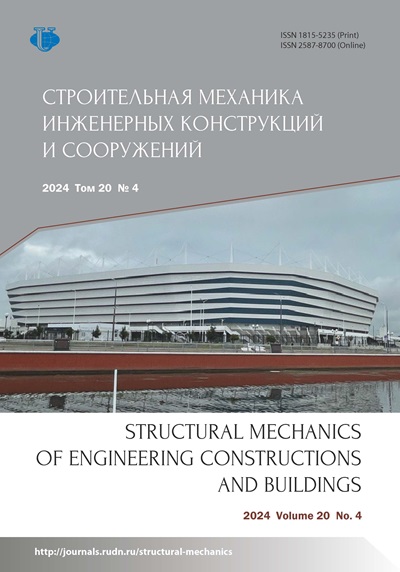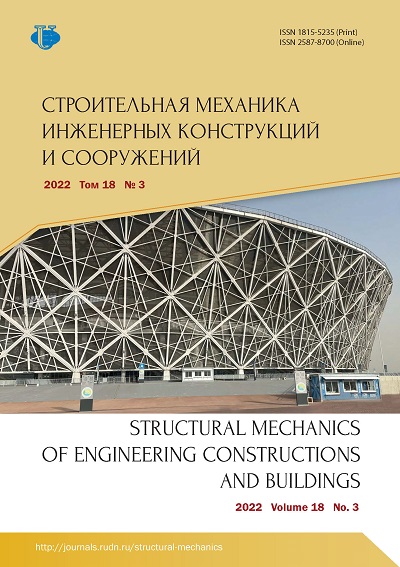On the basic architectural styles, directions, and style flows for shells and shell structures
- Authors: Krivoshapko S.N.1
-
Affiliations:
- Peoples’ Friendship University of Russia (RUDN University)
- Issue: Vol 18, No 3 (2022)
- Pages: 255-268
- Section: Theory of Thin Elastic Shells
- URL: https://journals.rudn.ru/structural-mechanics/article/view/32025
- DOI: https://doi.org/10.22363/1815-5235-2022-18-3-255-268
Cite item
Full Text
Abstract
It was ascertained that investigations on classification of architectural styles for shells and shell structures are absent. Only one published paper is available where architectural styles with indication of dates of appearance of the styles and dates of attenuation of their application are presented and the names of their founders are given. Now, the interest for the design, analysis, and building of thin-walled shells and shell structures is rising. There are no countries without erected shell structures. Hence, it is necessary to make more exact the classification of these erections and the distribution of them into groups. An aim of this work is collection of information about all known architectural styles as applied to shells and shell structures, and grouping of them due to characteristic traits and indications. All architectural styles were divided into five groups, i.e. avant-gardism, art deco style, modernism, ecotech style, and the newest styles. A special scheme, where distribution of architectural styles on these groups is applied to the examined structures, is given. Mutual influence of styles was revealed and presence of architectural directions and style flows in several styles was shown. The conclusions presented in this paper can demand the future accurate definitions and developments because specialists do not have common views to the list of architectural styles and to their classifications.
Keywords
About the authors
Sergey N. Krivoshapko
Peoples’ Friendship University of Russia (RUDN University)
Author for correspondence.
Email: sn_krivoshapko@mail.ru
ORCID iD: 0000-0002-9385-3699
DSc, Professor of the Department of Civil Engineering, Academy of Engineering
6 Miklukho-Maklaya St, Moscow, 117198, Russian FederationReferences
- Krivoshapko S.N., Alborova L.A., Mamieva I.A. Shell structures: genesis, materials, and subtypes. Part 1. Subtypes and directions. Academia. Architecture and Construction. 2021;(3):125–134. (In Russ.) https://doi.org/10.22337/2077-9038-2021-3-125-134
- Krivoshapko S.N., Galishnikova V.V. Architectural-and-building structures. Moscow: YuRAIT Publ.; 2019. (In Russ.)
- Krivoshapko S.N. Polyhedra and quasi-polyhedra in architecture of civil and industrial erection. Building and Reconstruction. 2020;(4):48–64. (In Russ.)
- Krivoshapko S.N. Shells and rod structures in the form of analytically non-given surfaces in modern architecture. Building and Reconstruction. 2020;(3):20–30. (In Russ.) https://doi.org/10.33979/2073-7416-2020-89-3-20-30
- Alborova L.A. Minimal surfaces in building and architecture. Biosphere Compatibility: Human, Region, Technologies. 2021;(1):3–11. (In Russ.) https://doi.org/10.21869/2311-1518-2021-33-1-3-11
- Ermolenko E.V. Forms and constructions on the architecture of the soviet avant-garde and their interpretation in modern foreign practice. Academia. Architecture and Construction. 2020;(1):39–48. https://doi.org/10.22337/2077-2020-1-39-48
- Bykov O., Gubkina I. Soviet Modernism. Brutalism. Post-modernism buildings and structures in Ukraine 1955–1991. Berlin: DOM Publishers; 2019.
- Barchugova E.V. Parametrism as a direction of the modern project activities. AMIT. 2013;(4):1–19.
- Mozhdegani A.S., Afhami I.R. Using Ecotech architecture as an effective tool for sustainability in construction industry. Engineering, Technology & Applied Science Research. 2017;7(5):1914–1917.
- Lytkin K.A. Architectural elements noospheric. Architecture and Construction of Russia. 2013;(1):30–39. (In Russ.)
- Mamieva I.A. Analytical surfaces for parametrical architecture in contemporary buildings and structures. Academia. Architecture and Construction. 2020;(1):150–165. (In Russ.)
- Zaslavskaya A.Y. Features, forming an architectural object, basing on fractal structures. Urban Construction and Architecture. 2011;1(2):15–17. https://doi.org/10.17673/vestnik.2011.02.4
- Chaubin Fr. Cosmic communist constructions photographed. Taschen; 2017.
- Waters J.K. Blobitecture: waveform architecture and digital design. Rockport Publishers; 2003.
- Krivoshapko S.N., Bock Hyeng C.A., Mamieva I.A. Chronology of erection of the earliest reinforced concrete shells. International Journal of Research and Reviews in Applied Sciences. 2014;18(2):95–108.
- Malinina T. Modernism and “modernisms:” on contents of an idea and expansion of its border to 21st century in architectural criticism. Methodological notes. Architecture. Theory and Practice. 2014;(3–4):106–125.
- Schumacher P. Parametricism – a new global style for architecture and urban design. AD Architectural Design – Digital Cities. 2009;79(4):14–23. https://doi.org/1002/AD.912
- Atkina L.I., Zhukova M.V., Morozov A.M. The basic architectural styles. The characteristic features. Ekaterinburg: UGLTU Publ.; 2015.
- Volichenko O.V. Conceptions of nob-linear architecture. Architecton: Izvestiya Vuzov. 2013;(44):21–39.
- Neporada V.I. Velaroidal shells in non-linear architecture. In: Mosin V.G. (ed.) Mathematical Methods in Architecture and Design: Conference Papers (15 May 2012). Samara: SGASU Publ.; 2013. p. 23–31.
- Fedchun D.O., Tlustiy R.E. System of generative design in architecture. Architecture and Design: History, Theory, Innovation. 2016;(1):285–289.
- Pakowska M. Parametric, generative, evolutionary, organic and bionic architecture – a new look at an old problem. Architecture et Artibus. 2014;(1):42–45.
- Volynskov V.E. Evolution as a strategy of projecting and designing in non-linear architecture. Housing Construction. 2011;(10):1–6.
- Krivoshapko S.N. Shell structures and shells at the beginning of the 21st century. Structural Mechanics of Engineering Constructions and Buildings. 2021;17(6):553–561. https://doi.org/10.22363/1815-5235-2021-17-6-553-561
















